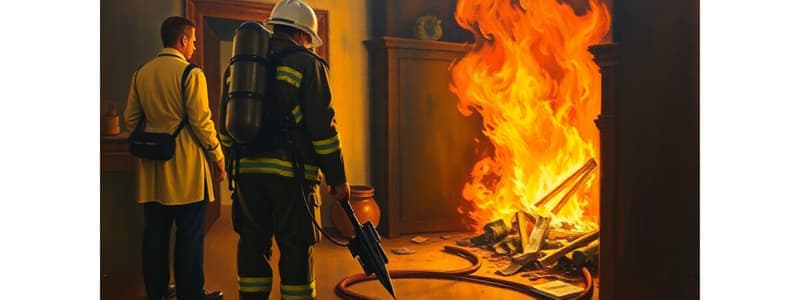Podcast
Questions and Answers
Firefighters extinguish a house fire and, while overhauling, discover a suspicious device. Under what condition can they remove the device from the scene without a warrant?
Firefighters extinguish a house fire and, while overhauling, discover a suspicious device. Under what condition can they remove the device from the scene without a warrant?
- If a neighbor claims to have witnessed the device being constructed earlier that day.
- If the property owner verbally consents to its removal after being informed of its nature.
- Under exigent circumstances, as long as the scene has not been officially released. (correct)
- If the device is in plain view and easily accessible.
After a fire scene has been released back to the property owner, what is required for investigators to re-enter and collect evidence?
After a fire scene has been released back to the property owner, what is required for investigators to re-enter and collect evidence?
- A criminal search warrant is always required, unless the fire was accidental.
- Either the property owner's consent or an administrative/criminal search warrant. (correct)
- A simple notification to the property owner is sufficient.
- Only an administrative search warrant is necessary, regardless of the owner's consent.
When is an administrative search warrant typically issued in fire investigation scenarios?
When is an administrative search warrant typically issued in fire investigation scenarios?
- After a preliminary investigation reveals code violations unrelated to the fire's cause.
- When criminal activity is immediately suspected at the fire scene.
- Only in cases involving federal properties or arson for profit schemes.
- When the property owner denies consent, and an agency has the responsibility to investigate the fire. (correct)
During a fire investigation, an investigator discovers evidence suggesting arson. What is the correct procedure?
During a fire investigation, an investigator discovers evidence suggesting arson. What is the correct procedure?
A private fire investigator is hired by an insurance company to determine the cause of a residential fire. The homeowner is hesitant to grant access to the property. What is the investigator's best course of action?
A private fire investigator is hired by an insurance company to determine the cause of a residential fire. The homeowner is hesitant to grant access to the property. What is the investigator's best course of action?
Flashcards
Exigent Circumstances
Exigent Circumstances
Allows fire personnel to enter and remove items to extinguish a fire, without owner consent, until the scene is released.
Consent of Property Owner
Consent of Property Owner
Once a fire scene is released, this is needed for entry, often used in the private sector.
Administrative Search Warrant
Administrative Search Warrant
Issued when an agency investigates a fire, especially if the owner doesn't consent.
Criminal Search Warrant
Criminal Search Warrant
Signup and view all the flashcards
Study Notes
- There are four methods for fire evidence removal.
Exigent Circumstances
- Fire personnel can enter a scene to extinguish a fire and remove items without the owner's consent.
- This is allowed up until the scene is released.
Consent of Property Owner
- Once the scene is released, entering requires the owner's consent or a search warrant.
- Consent is the usual method of entry for the private sector.
Administrative Search Warrant
- This is typically issued when an agency is responsible for investigating a fire.
- It is used when the property owner denies consent.
Criminal Search Warrant
- If potential criminal evidence is found during the investigation, processing must stop.
- A criminal search warrant must be obtained from a judge.
Studying That Suits You
Use AI to generate personalized quizzes and flashcards to suit your learning preferences.


